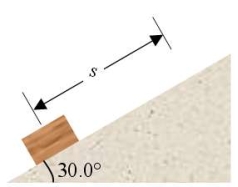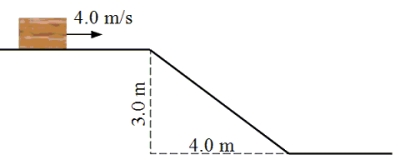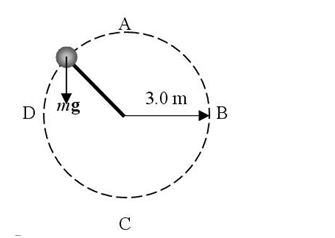A) 11.4 m/s
B) 16.1 m/s
C) 32.2 m/s
D) 131 m/s
E) 259 m/s
Correct Answer

verified
Correct Answer
verified
Multiple Choice
A physics student shoves a 0.50-kg block from the bottom of a frictionless 30.0° inclined plane. The student performs 4.0 J of work and the block slides a distance s along the incline before it stops. Determine the value of s. 
A) 8.0 cm
B) 16 cm
C) 82 cm
D) 160 cm
E) 330 cm
Correct Answer

verified
Correct Answer
verified
Multiple Choice
A 5.00-kg block of ice is sliding across a frozen pond at 2.00 m/s. A 7.60-N force is applied in the direction of motion. After the ice block slides 15.0 m, the force is removed. The work done by the applied force is
A) -114 J.
B) +114 J.
C) -735 J.
D) +735 J.
E) +19.7 J.
Correct Answer

verified
Correct Answer
verified
Multiple Choice
A pebble rolls off the roof of Science Hall and falls vertically. Just before it reaches the ground, the pebble's speed is 17 m/s. Neglect air resistance and determine the height of Science Hall.
A) 42 m
B) 33 m
C) 26 m
D) 21 m
E) 15 m
Correct Answer

verified
Correct Answer
verified
Multiple Choice
Two balls of equal size are dropped from the same height from the roof of a building. One ball has twice the mass of the other. When the balls reach the ground, how do the kinetic energies of the two balls compare?
A) The lighter one has one fourth as much kinetic energy as the other does.
B) The lighter one has one half as much kinetic energy as the other does.
C) The lighter one has the same kinetic energy as the other does.
D) The lighter one has twice as much kinetic energy as the other does.
E) The lighter one has four times as much kinetic energy as the other does.
Correct Answer

verified
Correct Answer
verified
Multiple Choice
What coefficient of friction would be required to keep the crate moving at constant speed under the action of the 325-N force?
A) 0.250
B) 0.321
C) 0.508
D) 0.663
E) 0.747
Correct Answer

verified
Correct Answer
verified
Multiple Choice
A force with a magnitude of 25 N and directed at an angle of 37° above the horizontal is used to move a 10-kg crate along a horizontal surface at constant velocity. How much work is done by this force in moving the crate a distance of 15 m?
A) zero joules
B) 1.7 J
C) 40 J
D) 98 J
E) 300 J
Correct Answer

verified
Correct Answer
verified
Multiple Choice
Which one of the following situations is an example of an object with a non-zero kinetic energy?
A) a drum of diesel fuel on a parked truck
B) a stationary pendulum
C) a satellite in geosynchronous orbit
D) a car parked at the top of a hill
E) a boulder resting at the bottom of a cliff
Correct Answer

verified
Correct Answer
verified
Multiple Choice
What power is needed to lift a 49-kg person a vertical distance of 5.0 m in 20.0 s?
A) 12.5 W
B) 25 W
C) 60 W
D) 120 W
E) 210 W
Correct Answer

verified
Correct Answer
verified
Multiple Choice
Which one of the following has the largest kinetic energy?
A) a raindrop falling
B) a woman swimming
C) a jet airplane flying at its maximum speed
D) the earth moving in its orbit around the sun
E) the space shuttle orbiting the Earth
Correct Answer

verified
Correct Answer
verified
Multiple Choice
An escalator is 30.0 meters long and slants at 30.0° relative to the horizontal. If it moves at 1.00 m/s, at what rate does it do work in lifting a 50.0-kg woman from the bottom to the top of the escalator?
A) 49.3 W
B) 98.0 W
C) 245 W
D) 292 W
E) 495 W
Correct Answer

verified
Correct Answer
verified
Multiple Choice
The amount of energy needed to power a 0.10-kW bulb for one minute would be just sufficient to lift a 1.0-kg object through a vertical distance of
A) 12 m
B) 75 m
C) 100 m
D) 120 m
E) 610 m
Correct Answer

verified
Correct Answer
verified
Multiple Choice
A 12.5-kg crate slides along a horizontal frictionless surface at a constant speed of 4.0 m/s. The crate then slides down a frictionless incline and across a second horizontal surface as shown in the figure.  -What is the kinetic energy of the crate as it slides on the upper surface?
-What is the kinetic energy of the crate as it slides on the upper surface?
A) 30 J
B) 80 J
C) 100 J
D) 200 J
E) 490 J
Correct Answer

verified
Correct Answer
verified
Multiple Choice
An experimental 1500-kg car travels at a constant speed of 22 m/s around a circular test track that is 80 m across. What is the kinetic energy of the car?
A) zero joules
B) 3.6 × 105 J
C) 3.3 × 104 J
D) 1.6 × 104 J
E) 7.2 × 105 J
Correct Answer

verified
Correct Answer
verified
Multiple Choice
A top fuel dragster with a mass of 500.0 kg starts from rest and completes a quarter mile (402 m) race in a time of 5.0 s. The dragster's final speed is 130 m/s. Neglecting friction, what average power was needed to produce this final speed?
A) 140 hp
B) 750 hp
C) 1100 hp
D) 2.7 × 104 hp
E) 8.5 × 105 hp
Correct Answer

verified
Correct Answer
verified
Multiple Choice
A 0.50-kg ball on the end of a rope is moving in a vertical circle of radius 3.0 m near the surface of the Earth where the acceleration due to gravity, g, is 9.8 m/s2. Point A is at the top of the circle; C is at the bottom. Points B and D are exactly halfway between A and C.  -Which one of the following statements concerning the tension in the rope is true?
-Which one of the following statements concerning the tension in the rope is true?
A) The tension is smallest at A.
B) The tension is smallest at C.
C) The tension is smallest at both B and D.
D) The tension is the same at A and C.
E) The tension is the same at A, B, C, and D.
Correct Answer

verified
Correct Answer
verified
Multiple Choice
A bicyclist is traveling at a speed of 20.0 m/s as he approaches the bottom of a hill. He decides to coast up the hill and stops upon reaching the top. Neglecting friction, determine the vertical height of the hill.
A) 28.5 m
B) 3.70 m
C) 11.2 m
D) 40.8 m
E) 20.4 m
Correct Answer

verified
Correct Answer
verified
Multiple Choice
Complete the following statement: Work may be expressed using all of the following units except
A) N . m.
B) joule.
C) erg.
D) ft . lb.
E) watt.
Correct Answer

verified
Correct Answer
verified
Multiple Choice
A 1.0-kg ball on the end of a string is whirled at a constant speed of 2.0 m/s in a horizontal circle of radius 1.5 m. What is the work done by the centripetal force during one revolution?
A) zero joules
B) 2.7 J
C) 6.0 J
D) 25 J
E) 33 J
Correct Answer

verified
Correct Answer
verified
Multiple Choice
Julie carries an 8.0-kg suitcase as she walks 18 m along a horizontal walkway to her hotel room at a constant speed of 1.5 m/s. How much work does Julie do in carrying her suitcase?
A) zero joules
B) 40 J
C) 200 J
D) 300 J
E) 2000 J
Correct Answer

verified
Correct Answer
verified
Showing 41 - 60 of 78
Related Exams